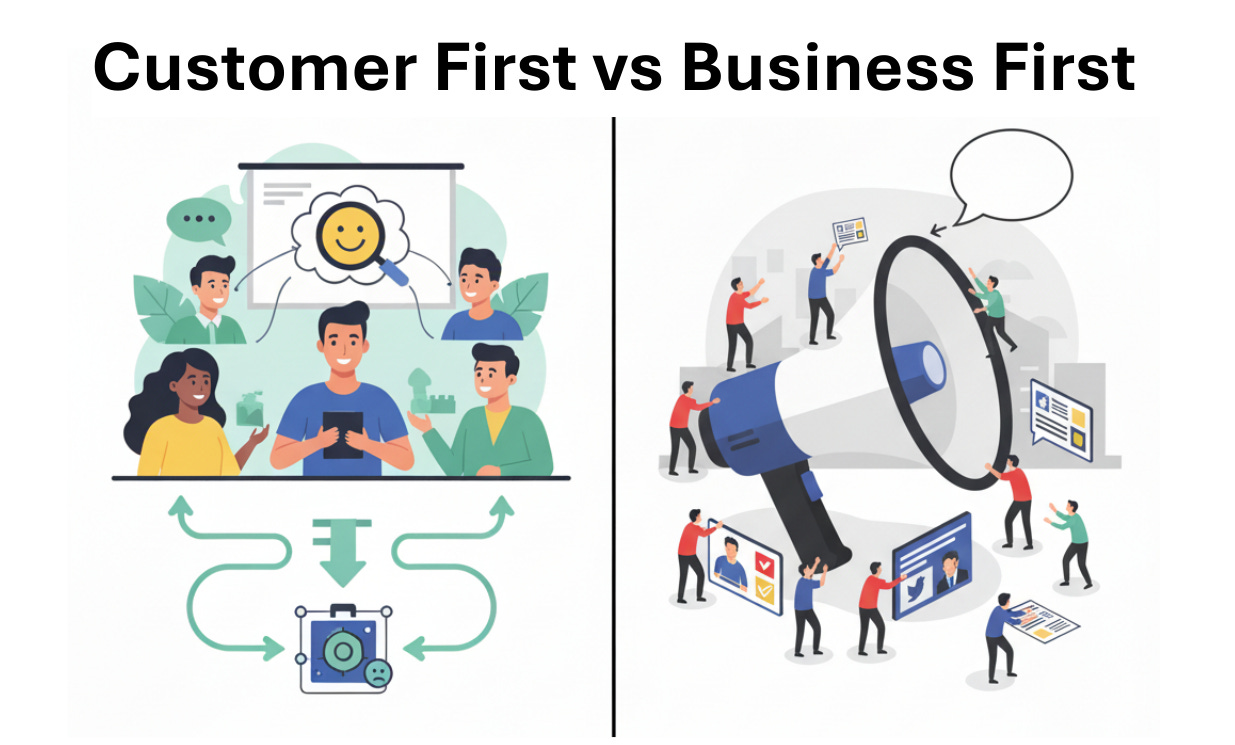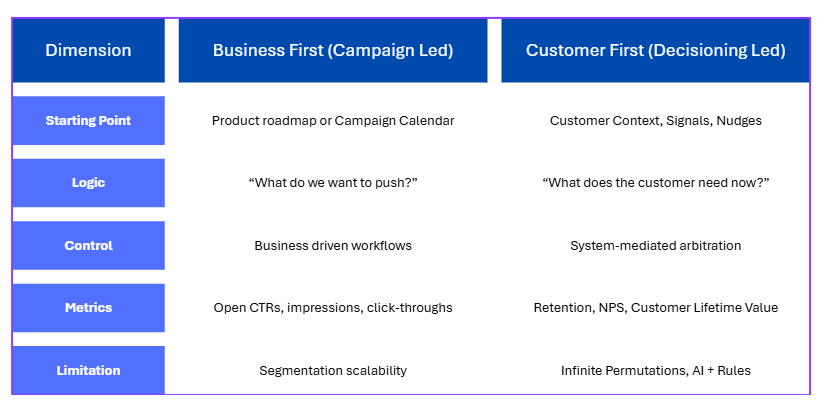Customer-First or Business-First? The Dilemma of Modern Marketing
Many organisations claim to put customers first, but their campaign tactics reveal a different truth: offers are driven by business priorities, not customer needs.
“Customer-first” has become one of the most widely used claims in the modern marketing. It appears in annual reports, leadership presentations, and corporate mission statements. However, closer look reveals a persistent tension between intention and practice. While organisations aspire to put customers at the centre of their decision-making, many continue to operate from a business-first perspective, prioritising internal objectives, product pushes, and campaign calendars over customer needs.
A simple litmus test helps distinguish the two:
If your organisation decides what offers to send to customers, you are business-first.
If customers, through their behaviour, signals, and context, decide what they want to receive, and your systems arbitrate in real time - you are customer-first.
This distinction is critical for understanding both the limitations of existing marketing practices and the conditions required to achieve genuine customer-centricity.

The Mirage of Customer-First
The evolution of business models over the past decades provides useful context:
Product-first organisations placed emphasis on innovation and distribution. Their success relied on producing goods or services at scale, under the assumption that demand would follow.
Marketing-first organisations shifted the emphasis to creating and stimulating demand. Campaigns, promotions, and segmentation became the organising principle, with the central question being - ‘How can we persuade customers to buy more of what we have to sell?’
With the rise of Marketing Automation Platforms (MAPs)—Eloqua, Marketo, HubSpot, Salesforce Marketing Cloud, Adobe Campaign - marketers gained new tools to reach customers at scale. Campaigns could be automated, journeys orchestrated, emails triggered. Suddenly, organisations claimed they were reaching “the right person, at the right time, with the right message.”
Nothing could be further from the truth.
In practice, MAPs operationalise workflows designed by marketers. The point of departure is not the customer’s lived context but the organisation’s campaign agenda. Many enterprises still run campaigns, define target audiences, and push offers, with much slicker automation than before. They also highlight the underlying mindset: product, channel, and campaign first.
This is not customer-first. This is business-first, with better software.
Metrics as a Revealing Indicator
Metrics are a mirror. They reveal what an organisation truly values.
A 2024 Zeta Global / Forrester study found that while 81% of firms can track Customer Lifetime Value, only 37% actively apply it to strategy, and just 14% are using it to inform marketing investment and execution.
McKinsey’s “Next in Personalization” study finds that 71% of consumers expect personalised interactions, and 76% express frustration when those expectations are not met.
According to Investigating the Importance of CLV, while Customer Lifetime Value is acknowledged as a crucial metric in relationship marketing and CRM, many firms struggle to use it operationally, whether in segmentation, resource allocation, or predictive decisioning.
This disconnect is telling. Organisations are measuring their own efficiency, not the customer’s outcomes, optimising for the number of communications delivered or opened rather than the value or relevance of those interactions.
Why Human Guesswork Can’t Scale
Achieving a genuinely customer-first orientation requires more than good intentions. It requires that every interaction across websites, mobile apps, emails, and contact centres, be informed by what the customer needs in the moment.
This expectation, however, confronts the reality of complexity. Customers typically interact across numerous channels, are eligible for multiple products or propositions, and generate a constant stream of contextual signals. Determining whether a customer should receive an offer, reassurance, service notification, or no communication at all requires evaluating thousands of permutations.
Relying on human teams to arbitrate these possibilities is impractical and impossible. Consequently, many organisations default to the more manageable but less effective practice of executing campaigns from a pre-determined calendar. This is not customer-first engagement, but business-first marketing executed with greater efficiency.
BCG argues that the traditional, linear customer journey or funnel is no longer valid because consumer behaviour is non-linear, unpredictable, and highly fragmented across channels and moments. The paper highlights that influence no longer respects clean funnel stages, with customers looping back, skipping ahead, or exiting and re-entering journeys unpredictably.
Business-First vs Customer-First: A Comparative Framework
This framework illustrates that the distinction is not merely technical. It reflects a deeper philosophical orientation: from prioritising organisational objectives to enabling customer choice at scale.
The limitations of MAPs
To be clear, Marketing Automation Platforms aren’t obsolete. They played a pivotal role in helping organisations scale communication in the 2010s. MAPs excel at executing predefined sequences, sending out scheduled communications, and managing segment-driven campaigns. They are superb at automating our processes and our communications. However, their architecture and design are centred around the marketer's agenda - what we want to send -rather than the customer's dynamic needs and preferences in that very moment.
While they can be configured for some level of personalisation, the underlying logic often remains: "If customer X does Y, then send Z." This is still an organisation dictating the next step, rather than enabling a customer-led flow. To truly be customer-first, even the most advanced MAPs need to be orchestrated by a sophisticated Customer Decisioning engine that places real-time customer intent at its core.
That’s why companies that rely solely on MAPs can’t credibly call themselves customer-first. At best, they’re running business-first campaigns more efficiently. At worst, they’re disguising old habits in the language of personalisation.
What It Takes to Be Customer-First
Shifting from business-first to customer-first requires more than swapping out platforms. It demands structural, cultural, and strategic change:
Re-architect the technology stack around a central decisioning capability.
Redefine metrics to emphasise customer outcomes (value, retention, satisfaction) rather than campaign outputs. If your teams are rewarded for campaign volume, you’ll never be customer-first.
Embed AI and decisioning logic to arbitrate in real time at scale.
Reposition MAPs as delivery mechanisms, not decision engines.
Shift organisational culture from campaign planning to decision enablement.
Spotify doesn’t ask, “Which campaign should we run this quarter?” Instead, its recommendation engine decides, in real-time, what to suggest to each listener. That’s why “Discover Weekly” feels magical because it starts with your behaviour, not with a marketer’s campaign calendar.
Customer Decisioning: The Key Enabler
Customer decisioning functions as the operating system of engagement, sitting between the data infrastructure and customer-facing channels. Its purpose is to determine - in real time, the most relevant action for each individual customer.
This is a fundamental shift. MAPs automate campaigns; decisioning orchestrates choices. The orientation changes from “what do we want to communicate?” to “what does this customer need now?”
This isn’t just theory. Leading research bodies are converging on the same conclusion: decisioning is essential for true customer-first engagement.
KPMG’s global research argues that customer-centric organisations push decision-making power closer to the customer - designing systems where customer preferences, feedback, and real-time behavior automate what comes next across channels, creating nimble and relevant experiences.
In the last quarter of 2023, 74% of consumers surveyed for Accenture’s Consumer Research 2024 walked away from purchases simply because they felt overwhelmed. Despite focus on customer-centricity and personalised experiences over the past few years, most people (71%) see no improvement or even see an increase, in the time and effort required to make a purchase decision.
Customer Decisioning Blueprint
Recognising the importance of decisioning is only the first step. To move from aspiration to execution, organisations need a Customer Decisioning Blueprint - a unifying architecture that defines how decisions are made, governed, and scaled.
Without such a blueprint, organisations risk fragmented approaches - each product, channel, or team improvising its own rules. This quickly leads back to business-first behaviours, with conflicting campaigns and disjointed experiences. A blueprint ensures that every decision whether it results in an offer, a service action, or silence is aligned to customer needs and enterprise priorities. It transforms decisioning from a tactical tool into a strategic capability.
This is why I am working on an exciting project in this space.
The Litmus test
At every MarTech conference, vendors and executives talk about “customer centricity.” However, the call to be customer-first is not just about a nice slogan; it’s about a fundamental shift in how we build our technology stacks, design our processes, and measure our success. If we are serious about putting the customer at the center, we must empower them to dictate their own journey, moving beyond a business-first dictatorial approach to a truly customer-led decisioning paradigm.
If your tools help you blast offers to the segmented audiences, you are Business First.
If your tools help you decide, in the moment, what’s best for the customer - even if that means not marketing at all, you are Customer First.
I am arguing that the future of MarTech belongs to the latter.
Requests
I’d love your feedback - it only takes a minute! Tell me what you think and what you’d like to read next. This is the Survey Link.
If you are a Customer Decisioning leader or practitioner whether on the brand side or vendor side, I’d love to have a chat with you about an upcoming project. Please feel free to drop me an email at pawan[@]martechsquare.com



From the 5 points you listed under Being Customer-Centric, the hardest one, by far is #5: Shift organisational. In non-tech companies and/or large companies, you can spend *years* just on this item, no mater if you already have the decisioning platform or CDP on place! It still takes a while to get the assets you need in order to feed the decisioning tool…(at least this has always been my experience…)